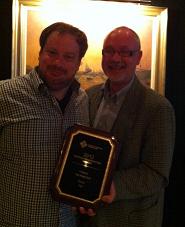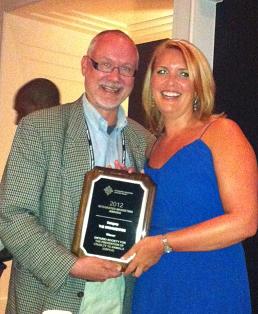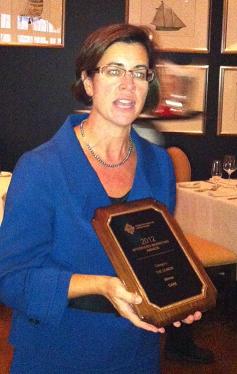
Your Nonprofit's Evolution to Multi-channel
This article was written by guest blogger Jennifer Atkins, Director of Marketing Programs at Blackbaud. The article originally appeared in Blackbaud's blog, Connection Cafe.
Multi-channel! Multi-channel! Multi-channel! It's all the rage, but do you know how close your organization is to achieving it? We've taken a look at what that journey looks like for an organization and have broken it down into 4 major stages: early, traditional, coordinated and optimized -- I know, we deserve bonus points for our naming creativity, but hopefully they are at least clear!
 I’ll go into a high-level view of each of these stages, but if you take a quick little quiz to find out where you’re at, you’ll get some really cool action plans for how to get to the next level!
I’ll go into a high-level view of each of these stages, but if you take a quick little quiz to find out where you’re at, you’ll get some really cool action plans for how to get to the next level!
Early Stage: Integration may be a goal but identifying how to get there can be a challenge.
- Minimal online marketing
- Calendar-based campaigning
- Not financially committed to a second channel
Traditional: You’ve moved some efforts online but they may not be coordinated with larger fundraising and communication strategies.
- Separate team and metrics for online marketing
- No calendar and/or campaign coordination
- Second channel constitutes 5-20% direct response revenue
- Separate databases for online/offline
Coordinated: You’ve conquered the structural challenges and are seeing results but can’t track cause and effect as well as you need to.
- Thematically integrated, some consolidation of data across channels
- Shared metrics
- Limited sensitivity to solicitation frequency
- Decisioning beyond RFM modeling
Optimized: You’re pushing the envelope but are always looking for ways to increase engagement with your supporters.
- Unified strategy and real-time data integration
- Measure success across channels, not by channel
- Donors’ behaviors and interests drives communication stream
- Shared budget and resources
And just remember, small changes can equal BIG IMPACT!
Share, Like and Post | | Article Link | Comment
How Measuring Individual Channels in Your Integrated Campaign Can Be Dangerous
Guest blogger Margaux Smith is a copywriter at the London fundraising agency, Bluefrog.
We’ve talked before on this blog about the importance of measuring the bottom line results when you’re looking at integrated fundraising campaigns, and this message was strongly reinforced during my recent talk with Rick Christ, Vice President of Online Fundraising at Amergent.
Integration can come in different forms. We commonly think of it as using one channel to uplift the results of an existing channel. For example, sending an email immediately before a direct mail appeal drops that tells the donor to expect a very important letter in the mail. The email doesn’t have an ask in itself, but uplifts the open rate of the appeal significantly, and drives the response rate up an average of 10-20%. Or, sending out a legacy mailing to prospective donors and following up with a phone call that lifts pledge rates.
email immediately before a direct mail appeal drops that tells the donor to expect a very important letter in the mail. The email doesn’t have an ask in itself, but uplifts the open rate of the appeal significantly, and drives the response rate up an average of 10-20%. Or, sending out a legacy mailing to prospective donors and following up with a phone call that lifts pledge rates.
These channel add-ons are easier to measure because you’re still largely looking at the results of the main appeal. But charities can get into trouble when they’re running larger campaigns that use different channels to raise funds separately. You have to keep in mind that today’s donors don’t always respond in the way you expect, but it doesn’t mean your channels are ineffective.
Rick shared his story of caution. “A few years ago, a prospective client called up and said, ‘We’ve noticed our DRTV ads are producing fewer and fewer gifts, and yet our website is bringing in more and more. So we’re thinking of taking some money out of DRTV and investing it online.’
“I asked how much they planned to shift and they said it might be a quarter of a million dollars. So of course, I cautioned them to wait. ‘Let us study where this web traffic is coming from,’ I told them. But they didn’t. They cut a large amount from their DRTV budget, and guess what –- the web stopped looking so good. Their website was the response device donors were using after viewing the TV ads. And they said, ‘But we don’t even put the website in our TV ads. It’s our 1-800 phone number that’s shown.’ Well that’s fine, but people aren’t so dumb that they can’t find you online. Donors these days respond in the way that feels most comfortable for them and increasingly, that’s online.
“The danger in measuring channel by channel is, let’s say you spent an extra 5% on social media, but find the increase in your social media fundraising was only 1%. So the amount of money that came in was only 20% of what you spent in social media. The immediate indication would be, well that was a loser. But you have to look at what came in online, in the mail and over the phone to see if they went up. Your channels may be reinforcing each other, which is hard to measure without looking at the big picture. That’s why measuring the bottom line becomes so important when you integrate your fundraising.”
Share, Like and Post | | Article Link | CommentCelebrating the Integrated Marketing We Want to See More Of
"Celebrate what you want to see more of" -- Thomas J. Peters
All nonprofit organizations struggle with the challenge of integrated marketing in their organizations -- facing limited budgets and limited examples of best practices. The Integrated Marketing Advisory Board (IMAB) was founded in the fall of 2011 to help begin to meet some of these challenges. With just over a half year of inagural work completed by the board members, we celebrated integrated marketing best practice with our first awards dinner last week.
There was excited conversation between the board members and the three nonprofit award recipients around the challenges of integrated marketing and how the recipient organizations (TVO, Ontario SPCA, and CARE USA) worked hard to overcome some of the barriers of integrated marketing to run successful campaigns. The award winners beat out a who's who list of competitors, and we were proud to present them with their well-deserved plaques.
And to follow the Thomas Peters' quote above, the IMAB sees this as just the beginning of not only an award that will grow in meaning, prestige, and participation from the charitable sector BUT also sharing of case studies of the award winners and all entrants (who were all worthy of winning) and make sure they appear on www.imabgroup.net over the next few months.
IMAB is excited for the winners but even more excited to share these best practice examples to inspire the whole nonprofit sector!



Announcing the 2012 IMAB Integrated Marketing Award Winners
Today, the Integrated Marketing Advisory Board (IMAB) announced the winners of its first-ever annual Integrated Marketing Awards. The Integrated Marketing Awards recognize nonprofit organizations showing exemplary leadership in the area of integrated marketing.
organizations showing exemplary leadership in the area of integrated marketing.
We awarded three Integrated Marketing Awards, one in each of three categories:
- The Donor: How did an organization’s integrated marketing campaign or program have an impact on donor satisfaction and the donor experience?
- The Organization: How did an effort across an entire organization demonstrate alignment of strategy, structure, culture and skills to showcase integrated marketing efforts?
- The Practice: A real-world case study that highlights best practices in the field of integrated marketing.
We congratulate this year’s winners, who help to exemplify the sector’s successful use of integrated, multi-channel marketing campaigns or programs. The IMAB is privileged to honor these organizations that are demonstrating best practices in the field of integrated marketing.
Winners by Category:
The Donor
CARE, a leading humanitarian organization fighting global poverty, won in the category of The Donor for demonstrating how an integrated marketing campaign or program had an impact on donor satisfaction and the donor experience. The organization added coordinated mail and email invitations and follow-ups to extend their annual Donor Conference Call to an audience beyond its traditional direct mail donors. Call attendance was 75% higher than in past years and was split relatively evenly between donors and non-donors.
The Organization
The Ontario SPCA, one of the largest animal welfare organizations in Canada, won in the category of The Organization, demonstrating how an effort across the organization aligned strategy, structure, culture, or skills to impact the organization’s ability to integrate its marketing efforts. The Ontario SPCA developed an integrated marketing strategy to support its province-wide Friends for Life! walk-a-thon event, with the organization’s provincial office working with community branches to build a single event brand and communicate to participants, donors and prospects across all media channels.
The Practice
TVO, Ontario's public education media organization, won in the category of The Practice for sharing its real world case study highlighting best practices in the field of integrated marketing. The organization integrated all aspects of its annual plan -- integrating direct mail, email, web, television, telephone, and face-to-face communication channels with consistent messaging to retain current donors and acquire new ones. The organization saw an increase in quarter-over-quarter income over the previous year, and its integrated approach has been used as a case study in multiple fundraising conferences.
We will be featuring case studies from these organizations in future posts, so stay tuned!
Share, Like and Post | | Article Link | CommentHow to Sell Integrated Marketing to Non-Believers
Guest blogger Margaux Smith is a copywriter at the London fundraising agency, Bluefrog. After completing a post-graduate in Fundraising at Humber College in Toronto, Canada, she moved to the UK. She believes integrated marketing has become vital for the success of nonprofits, and looks forward to learning more as strategies evolve.
If you’ve been reading this blog for a while now, you probably have a pretty good idea about why you should be integrating your fundraising channels, and even how to get started. But you’ll also know that as fundraisers, we often aren’t in charge of making the final decisions. Even if you have the greatest strategic fundraising plan, you’ll have a hard time putting it into action without first getting the right people on board.
So how can you convince your boss, your CEO or your Board of Directors to give the go-ahead to things like:
- allowing resources for social media,
- giving the fundraising department control over website messaging,
- attaching a telemarketing campaign on the back of direct mail appeals, and
- all the other ways you can help send seamless messaging out across your organization?
Finding data and tests to back up your proposals is important, of course. But while talking to SCA Direct’s Jeanne Harris a few weeks ago, I noted a simple but clever tip:
“We’re not an integrated marketing agency,” she explained. “We’re a donor-centric agency.”
And who would argue with that? Simply by changing the language they use, they’re presenting an idea everyone can wrap their heads around.
So if you’re trying to convince the powers that be to get on board with your ideas by using marketing jargon like "integration," "multi-channel," or "campaign strategy," you may inadvertently be driving them towards thoughts of high costs and misspent time. Instead, try approaching them with the idea of making your fundraising more "donor-centered." It’s about looking at how you communicate through your donor’s eyes. And, I bet you’ll feel less resistance.
Jeanne went on to make a strong case. “You have to know what your audience is doing, where and when, in order to remain relevant. Then demonstrate you’re listening by communicating with them about what they’re truly interested in.
“We no longer control our donor relationships; our donors do. So we’ve got to be really thoughtful and careful about providing a consistent messaging platform so that no matter where people go, it makes sense.
“As the demographics of our donors shift, those now approaching old age are expecting more from organizations with respect to the donor experience, accountability of organization and familiarity with technology. We need to be transparent and allow for increased engagement, allowing donors to participate and be involved. We cannot afford to remain stagnant.”
Share, Like and Post | | Article Link | Comment

















